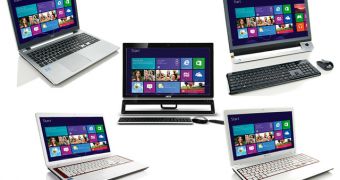Windows 8 was supposed to lend a hand to the collapsing PC market from the very beginning, especially because every new version of Windows stirred up interest in new computers after they got launched.
This time, however, the PC industry has continued its decline, with Windows 8 making almost no difference after the October 2012 release.
A new forecast released by IDC indicates that PC sales dropped more than 10 percent in 2013 as compared to the previous year, with analysts pointing out that this mostly happened because users see no reason in replacing an older computer.
This is where Windows 8 comes into play. The number of changes and modifications that Microsoft made in its modern operating system are keeping users away from new PCs running this particular software, as many prefer to stick to their old platforms.
“The emergence of 2-in-1 devices designed to function in both clamshell and slate configurations — many of which will run Windows — along with Windows-based tablets themselves, is expected to provide some new volume for the Windows platform as well as the PC vendors and other parts of the traditional PC ecosystem in coming years,” IDC analyst Loren Loverde said.
“However, relative to a PC market size of roughly 300 million units, these Windows tablets would add just a couple percent a year relative to PC growth.”
At this point, Windows 8’s adoption rate is still below expectations, but the good news is that more and more users are actually migrating to Windows 8.1.
Microsoft hasn’t talked too much about Windows 8 sales, but according to previous reports, shipments have been fairly disappointing.
The reason is as simple as it could be. Users who buy new computers choose to downgrade to Windows 7 in an attempt to get a more familiar working environment, while those who move from an older OS version to a newer one do not pick Windows 8 as their next destination.
The majority of Windows XP users, for example, go for Windows 7, especially because it’s the latest Windows version that comes with a Start Menu and a familiar user interface.

 14 DAY TRIAL //
14 DAY TRIAL //